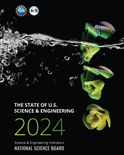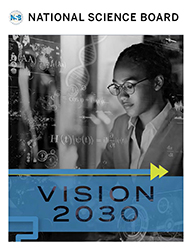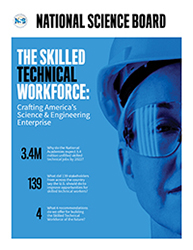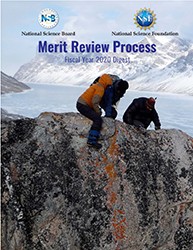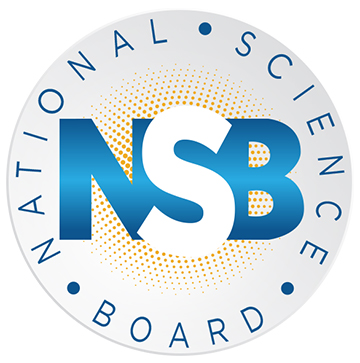
The Importance of Providing Open Science
Open access scientific publications rose much faster than closed access over past decade
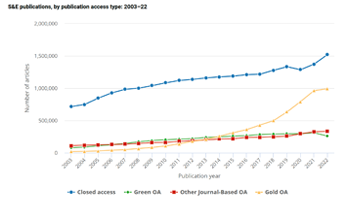
Science and engineering publications, by access type: 2003–22 (Credit and Larger Version)
December 11, 2023
Scientific articles that are freely available to the public grew by more than seven-fold in volume and increased in influence relative to those behind paywalls from 2003 to 2022, according to a new report. In 2022, 51% of articles, of which status we know, were in open access journals compared to 23% in 2003.
These and similar trends are in the Publications Output: U.S. Trends and International Comparisons report that the National Science Board published today as part of the 2024 congressionally mandated Science and Engineering Indicators suite of products on the state of the U.S. science and engineering enterprise. The reports are prepared by the U.S. National Science Foundation’s National Center for Science and Engineering Statistics under the Board’s guidance.
“It is encouraging to see this growth in open access science,” Suresh Garimella, the President of the University of Vermont and National Science Board Strategy Committee Chair, said. “Although the cost to authors and institutions can pose inequitable opportunities to use open access publishing, providing free public access to scientific papers helps expand and democratize knowledge,” Garimella said. “We must rethink how we approach open access publishing in order to promote all scientific voices, regardless of monetary constraints.”
Researchers typically use scientific publications to share original work with other scientists or to review existing research. Published literature is a useful way to monitor the evolution of modern science, and, ultimately, the state of a nation’s science and engineering enterprise.
In addition to open access trends, the new report shows data on research publication output by region, country, and scientific field. It includes data that reveal how impactful an entities’ research is and how much countries are collaborating with each other.
The Publications Output report pulls bibliometric information on science and engineering publications from Scopus, a database of scientific literature with English-language titles and abstracts. The report analyzes almost 44 million English-language articles published from 2003 to 2022. The report looks at author affiliation data to determine country output, among other factors.
The report includes papers published in conference proceedings and in peer-reviewed scientific and technical journals. It excludes editorials, errata, and letters.
Access for all
The Office of Science and Technology Policy announced that all federal agencies should update their public access policies as soon as possible to ensure that results of their funded research are publicly available, with full implementation of these policies by the end of 2025.
Although there has been a steady shift to more open access papers, publishing research as open access often requires authors to pay article processing fees, which may be prohibitive for some. The fees could be seen as shifting the cost of accessing research from the readers and libraries to the authors.
However, open access articles’ scientific impact has remained robust and even grown in some categories as the overall number of open access articles has dramatically risen.
Where the Scientific Publications Are
China continues to overtake the U.S. in science and engineering research publications, including in critical fields like Artificial Intelligence, although the U.S. continues to have large influence in the fields.
China first passed the U.S. in number of publications in 2015 and is now much closer to doubling the number of publications the U.S. produces. Furthermore, China’s growth in influential articles, or articles that are frequently cited by other articles, is also outpacing its overall growth as of 2020.
Behind China and the U.S., India produced the third largest number of publications in 2022. China’s top scientific field in terms of number of articles produced was engineering (25% of all publications). The top field in the U.S. was health sciences (37%) and in India was computer and information sciences (21%).
In the U.S., the fastest growing fields between 2010 and 2022 were psychology (up 39%) and the social sciences (up 38%). Fields with the largest decreases in U.S. publications were physics (down 31%) and materials science (down 16%).
International collaboration on science and engineering articles jumped from 19% in 2012 to 23% in 2022. The United Kingdom had international coauthors on 37% of their articles in 2003 but 67% in 2022. Germany’s rate increased from 39% to 56% over the same period. The United States and Japan both saw notable increases in international collaborations between 2003 and 2022 (from 23% to 40% and from 19% to 32%, respectively), whereas there was less change in the rates for China (from 15% to 19%) and India (from 19% to 24%).
Higher overall publication output with a growing number of diverse collaborations indicates that more countries are contributing to science and engineering publications, and many are working with U.S. authors.
For example, Artificial Intelligence is an important technology-intensive area that has grown rapidly in recent years and in which international collaborations are crucial. Country partnerships influence advancements in the field and as of 2022, the U.S. and China partnered with each other far more than other countries. Furthermore, the top 10 most prolific pairs in Artificial Intelligence fields all include the United States or China.
Publication Output is the fourth of 10 Science and Engineering Indicators reports that the NSB will publish over the coming months through spring of 2024.
About Science and Engineering Indicators
Science and Engineering Indicators is a congressionally mandated report on the state of the U.S. and international science and engineering enterprise. Indicators provides high-quality quantitative information on the enterprise in a series of reports and a data tool that provides state-level data.
About the NSB
The National Science Foundation Act of 1950 charged the NSB with two roles: to be the governing board of the NSF and an advisor to Congress and the President on policy matters related to STEM research and STEM education. Selected for their distinguished service and accomplishments in academia, government, and the private sector, the Board’s 24 presidentially appointed members are leaders in STEM research and education.
About the NCSES
NSF’s National Center for Science and Engineering Statistics (NCSES) is the nation's leading provider of statistical data on the U.S. science and engineering enterprise. As a principal federal statistical agency, NCSES serves as a clearinghouse for the collection, interpretation, analysis, and dissemination of objective science and engineering data.
Media Contact: Elizabeth Jeffers, National Science Board, (703) 292-7496, ejeffers@nsf.gov
The U.S. National Science Foundation propels the nation forward by advancing fundamental research in all fields of science and engineering. NSF supports research and people by providing facilities, instruments and funding to support their ingenuity and sustain the U.S. as a global leader in research and innovation. With a fiscal year 2023 budget of $9.5 billion, NSF funds reach all 50 states through grants to nearly 2,000 colleges, universities and institutions. Each year, NSF receives more than 40,000 competitive proposals and makes about 11,000 new awards. Those awards include support for cooperative research with industry, Arctic and Antarctic research and operations, and U.S. participation in international scientific efforts.
Useful NSB Web Sites:
Home Page: http://www.nsf.gov/nsb
Media Contact: http://www.nsf.gov/staff/staff_bio.jsp?lan=nlymn&org=NSF
News: http://www.nsf.gov/nsb/news
Meetings: http://www.nsf.gov/nsb/meetings
Publications: http://www.nsf.gov/nsb/publications
Facebook: https://www.facebook.com/NationalScienceBoard
Twitter: https://twitter.com/NSF_NSB
YouTube: https://www.youtube.com/channel/UCkrHRzuGSrPp2haQs0T_Pww
To view PDF documents, please download Adobe Acrobat Reader.
Useful NSB Web Sites:
Home Page: http://www.nsf.gov/nsb
Media Contact: http://www.nsf.gov/staff/staff_bio.jsp?lan=nlymn&org=NSF
News: http://www.nsf.gov/nsb/news
Meetings: http://www.nsf.gov/nsb/meetings
Publications: http://www.nsf.gov/nsb/publications
Facebook: https://www.facebook.com/NationalScienceBoard
Twitter: Twitter: https://twitter.com/intent/user?screen_name=NSF_NSB
YouTube: https://www.youtube.com/channel/UCkrHRzuGSrPp2haQs0T_Pww
To view PDF documents, please download Adobe Acrobat Reader.
